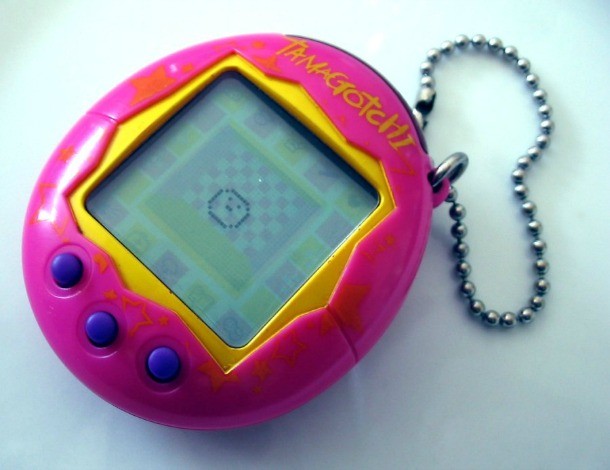Please support Game Informer. Print magazine subscriptions are less than $2 per issue
How Tamagotchi Changed The World

Before you call me crazy, hear me out: The virtual pet fad from the late ‘90s anticipated the future of the game industry.
Like millions of gamers, I’m addicted to Tiny Tower. Nimblebit’s mobile building management sim is cute, addictive, and low-impact enough to make me question whether it’s a game at all. There’s not much of what I consider proper gameplay. You just check in with your tenants every few hours, restocking items in the various businesses and build new floors when you’ve collected enough money. Because the main actions run on a timer (for example, it takes 25 real-time minutes for the workers to restock the Pub with hot wings), you rarely spend more than a few minutes at a time issuing commands. Then, your phone goes back in your pocket until your next free moment.
It’s a brilliant design, and perfect for the mobile market. It’s simple enough that anyone can play, and rarely requires more than a few minutes of play at a time. However, you form a powerful attachment – even a sense of responsibility – to your virtual citizens. If I go an unusually long time without checking in and find the business closed for lack of product, I feel like an irresponsible landlord.
This sense of responsibility – as well as the formula focused on frequent engagement – is what first reminded me of Tamagotchi, the interactive “virtual pet” keychain toy of the mid-to-late 1990s. At the time, it was viewed as just another fad like pogs or Razr scooters – and, in many ways, it was. However, some of the key elements of Tamagotchi anticipated many of the most successful games in the emerging mobile and social gaming space.
Since the rise of the modern era of gaming – for argument’s sake, let’s say sometime in the ‘80s when arcades began to give way to more complex home PC and console gaming experiences – the industry has been typified by games that are tailored towards longer, highly engaged gaming sessions. This is true of games ranging from the The Legend of Zelda to Battlefield 3.
However, Tamagotchi anticipated a new paradigm, one where the gamer doesn’t so much play a game as “tend” it. Each Tamagotchi (an egg shaped keychain with an LED screen) gave the owner the experience of owning a virtual pet. The pet had to be fed, cleaned, and cared for. It was a keychain, so it was always in your pocket. None of the “gameplay” was complex, but this sense of responsibility and ownership coupled with the portability and “always on” nature of the Tamagotchi’s internal clock was a powerful draw. Tamagotchi became a worldwide sensation, selling millions of units for Bandai and spawning imitators like Nintendo’s Pocket Pikachu.
Flash-forward over a decade, and Tamagotchi’s basic formula – a simple mobile experience that a player engages with in several short sessions a day – is all around us. Whether its the aforementioned Tiny Tower, social games like Farmville, or turn-based “asynchronous multiplayer” games like Draw Something or Words With Friends, gamers are relating to games in a new way. This low-impact/frequent engagement model is perfect for the mobile market, where – like Tamagotchi – games are often something used to kill time while riding the bus or waiting for food at a restaurant. Tamagotchi is primitive in terms of technology, but the fundamental relationship it establishes with the gamer is the same as many of today’s mobile blockbusters.
While it’s now a barely remembered curio of the last century, I think Tamagotchi deserves its due. Its influence is everywhere in an industry that’s looking for ways to keep its audience engaged all throughout the day and on multiple devices. Sometimes a cheap little plastic keychain really can change the world.










